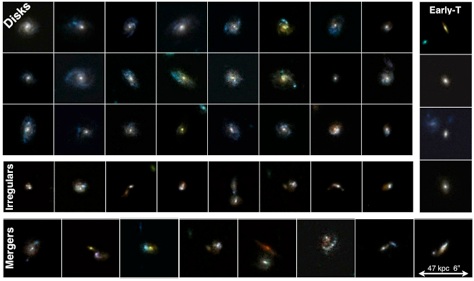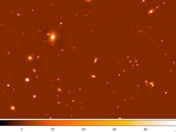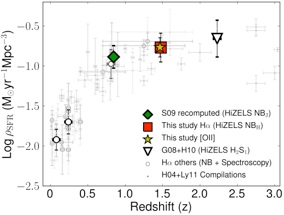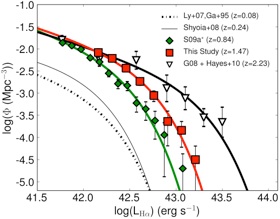HiZELS
HiZELS is a panoramic extragalactic survey using the WFCAM instrument on the 3.8-m UK Infrared Telescope (UKIRT). The survey uses a set of existing and custom-made narrow-band filters in the J , H and K bands to detect emission line galaxies at z = 1-9 over ∼ 5 square degrees of extragalactic sky, mostly in the UKIDSS DXS survey regions. Strong emission line galaxies include both star-forming galaxies and systems where Active Galactic Nuclei (AGN) contribute to significant line emission. The H2(S1) narrow-band filter is used to target Hα emitting galaxies at z=2.23, which are likely to be predominantly star-forming systems. In addition, custom narrow-band filters have been done. These target the [OII] emission line at 3727 A and the [OIII] line at 5007A, in galaxies at the same redshift as the Hα survey. Together, the three sets of filters can be used to investigate the [OII] 3727, [OIII] 5007 and Hα emission from galaxies at z=2.23 to distinguish star-forming systems from AGN, while the J and H narrow-band filters deliver identically-selected Hα samples at z=0.84 and 1.47 respectively. The comparisons between the luminosity function, the clustering and variation with environment of these Hα-selected samples across z=0.8-2.2 will yield unique constraints on the evolution of star-forming galaxies. More speculatively, the J-band filter is sensitive to Lyα emission from galaxies at z=8.90 and may detect a few such sources if current theoretical predictions are correct. Currently, most of the work is being done in Edinburgh and Durham.
Emission-line surveys are a particularly powerful method for tracing the evolution of star formation (and to a lesser extent AGN activity) as a function of cosmic epoch. With the advent of large-format imaging cameras in the optical and more recently in the near-infrared, we can exploit narrow-band filters to undertake sensitive and unbiased surveys for emission-line objects lying in well-defined large volumes across the relevant redshift range (out to z~2.5), and potentially yielding thousands of sources. The main benefits of such surveys for studies of star formation are that the sources are identified on the strength of their emission line and thus crudely represent a star-formation rate-selected sample, and that they must lie in a narrow range in redshift. Hence, using a number of narrow-band filters it is possible to apply a single technique to target H-alpha emitters across a wide range of redshifts, yielding large and representative samples at each epoch and with a uniform selection function. Such samples are ideal for tracing the evolution in the star-formation rate density across the era of peak activity in galaxies.
It is not only the global average star formation rate which is important for our understanding of galaxy formation and evolution, but more crucially the nature and distribution of the star forming galaxies at high redshifts. Many recent results point towards the star formation in the most massive galaxies occurring earlier than that in lower mass galaxies - so-called down-sizing, although the epoch of star formation of the most massive galaxies is currently poorly constrained. At low redshift, the star formation rates of galaxies are also greatly influenced by the environment in which they reside with star formation strongly suppressed in dense environments. To what extent is it the build-up of galaxies into groups and clusters since z~1 that drives the decline in the cosmic star formation rate? This question can only be addressed by examining how the relationship between star-formation rate and environment evolves with redshift. Large H-alpha surveys over the redshift range z = 0-2 would provide an uniquely powerful tool for measuring the growing influence of environment on star-forming galaxies, and determine how the characteristic stellar mass of star forming galaxies changes with epoch. Such observations would yield key tests of current galaxy formation models, such as the GALFORM semi-analytic model developed in Durham. We demonstrate this with the figure which compares the clustering strength of emission-line selected galaxies predicted by two flavors of the GALFORM code (which differ in the way they handle merging and feedback) and which show significantly different clustering properties for these strongly star-forming galaxies at high redshifts.
HiZELS will be roughly two orders of magnitude larger than previous near-infrared, narrow-band surveys. It will detect several thousand H-alpha emitting galaxies at each of three redshifts (0.84, 1.47 and 2.23) spanning the likely peak in the star formation density of the Universe. This will be the first time that the luminosity function of star forming galaxies has been accurately determined at these epochs in a robust and uniform manner, and will pin-point the epoch when the star formation density of the Universe peaked. The angular cross-correlation function of the star forming galaxies, and its evolution with redshift, will be determined with sufficient accuracy to place tight constraints upon models of galaxy formation. The survey will also measure the growing influence of environment on star-forming galaxies, and any variations in the characteristic mass of the most active galaxies. It may also provide the first detection of the star forming galaxy at z=9.
HiZELS has been allocated a total of 560 hours of time on UKIRT to date, of which 110 hours have been used for a pilot study covering 1.5 square degrees in the COSMOS and UKIDSS/UDS fields.
The membership of HiZELS is:
- Philip Best (co-PI), Institute for Astronomy, Edinburgh University
-
-Ian Smail (co-PI), Institute for Computational Cosmology, Durham University
-
-David Sobral, Leiden Observatory, Leiden University
-
-Jim Geach, McGill University
-
-Mark Casali, European Southern Observatory
- Gavin Dalton, Oxford University
- Rob Ivison, Astronomy Technology Centre, Edinburgh University
- Jaron Kurk, Max Planck Institute for Astrophysics, Heidelberg
- MIchele Cirasuolo, Astronomy Technology Centre, Edinburgh University
HiZELS: The High-z Emission Line Survey

HiZELS is a panoramic extragalactic survey using the WFCAM instrument on the 3.8-m UK Infrared Telescope (UKIRT). The survey uses a set of existing and custom-made narrow-band filters in the J , H and K bands to detect emission line galaxies up to z=9 over square degree areas of extragalactic sky. Important results on the nature, clustering and evolution of star-forming galaxies have already been published in Geach et al. (2008), Sobral et al. (2009a,b), Garn et al. (2010), Sobral et al. (2010), Sobral et al. (2011a,b).

Star forming galaxies at z∼1 are mostly disks and it’s their evolution that causes the clear decrease in the star-formation of the Universe as a whole. Mergers only account for ~20% of the star-formation over the last 10 billion years.

HiZELS is showing for the first time, with large and significant equally narrow-band selected samples, the clear evolution of the Hα luminosity function from z~0 to z~2.23, covering the bulk of the age of the Universe.
The large samples of 1000s of emitters at different redshifts and in different fields allow to undertake unprecedented detailed studies on the nature, morphology, evolution, clustering and environment of star-forming galaxies at high redshift. Together, they are providing a consistent picture of the evolution of these galaxies, along with strong tests on several models of galaxy formation and evolution.
The survey is also sensitive to Lyα emission at z=9, and it already allowed the tightest constrain of the bright end of such luminosity function (Sobral+09b).




